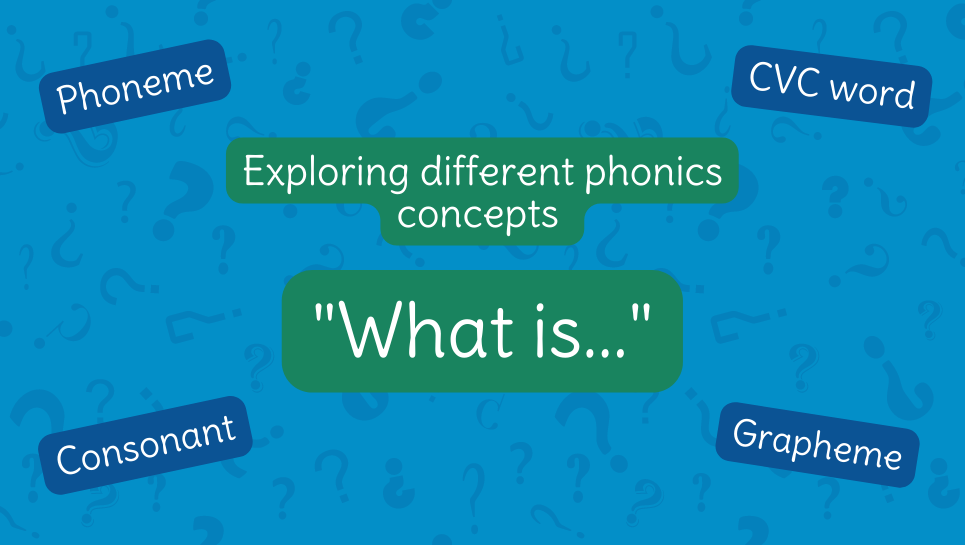In our ‘what is…’ series we’re taking things back to basics! From phonics to decoding, blending and more, we’re going to break things down and give you our expert advice on each area, to help answer any questions you may have around teaching reading.
***
When we read a new word, we need to be able to do three things:
- Recognise the letters on the page to be able to convert them to sounds of speech.
- Push those sounds together and ‘blend’ them into a word.
- Match the word we hear to a word stored in our lexicon to gain meaning.
For beginner readers most words are new, so they need to go through this process for almost every word. That is why reading is so laborious for novice readers. Children learning to read English take a great deal longer to become fluent than children learning to read in other languages. This is because the English Alphabetic Code is complex. We must teach it in a systematic and structured way as we would teach anything complex.
What are the complexities of the English Alphabetic Code?
- 26 letters are used and reused in many different combinations to represent the 44 sounds of speech. There are more than 170 letter combinations!
- A sound (phoneme) can be represented by 1-4 letters: ‘c a t’; ‘sh o p’, ‘n igh t’ and ‘d ough’.
- A sound (phoneme) can be spelled in numerous ways, e.g. the sound /ee/ can be spelled ‘ee’ as in ‘bee’, ‘ea’ as in ‘cream’, ‘e’ as in ‘he’, ‘ie’ as in ‘field’, ‘y’ as in ‘funny’, etc.
- A spelling (grapheme – letter or letter combination) can represent different sounds, e.g. the letters ‘ea’ can be pronounced /ae/ as in ‘great’, /e/ as in ‘head’ and /ee/ as in ‘team’.
One can see that with such complexity it is imperative to teach children how the code works in a systematic and logical way. This is called the ‘scope and sequence’ of a phonics programme.
Where to start? Start simple!
We start by introducing the letter/sound relationships of the sounds of the alphabet in small incremental and cumulative steps.
Step 1: 1:1 correspondence in CVC words
Quality phonics programmes will start by introducing the sounds of the alphabet. At this point sounds are spelled by one letter. This is called 1:1 correspondence (1 sound – 1 letter). Children will learn to read words with three sounds. They are called CVC words (consonant/vowel/consonant words) like ‘cat’. We teach children to read these words because there are many CVC words, and they can apply their novice phonics skills to read these simple words.
Step 2: Reading words with four and five sounds
Once children can read CVC words, they will be taught to read longer words with four sounds: CVCC (‘land’) CCVC (‘frog’) and CCVCC (‘print’). This is an important step, and many children need a great deal of practice to progress from CVC to consonant blends (consonant clusters).
Step 3: Introducing 1:2 correspondences
Now that students can read many words with 1:1 correspondence, two-letter spellings are introduced, e.g. ‘sh’. This is called 1:2 correspondence (1 sound – 2 letters). Further on, words with three- and four-letter spellings will be taught (1:3 and 1:4 letter/sound correspondences).
Step 4: Introducing multisyllabic words
Once children are secure reading one syllable words, two and three syllable words are introduced.
Step 5: Introducing morphology
Finally, children can learn about how English is built of morphemes, the smallest units of meaning in words, e.g. ‘un’ at the beginning and ‘able’ at the end of the word: ‘unacceptable’. This will help them expand their vocabulary, spelling, and comprehension.
Once students have been taught these steps, they apply their phonics knowledge and skills to reading text until they develop reading fluency. At the early stages they will apply their reading skills to decodable texts, but as they learn enough of the Alphabetic Code, they will be able to decode any new word they encounter in grade-appropriate texts.


